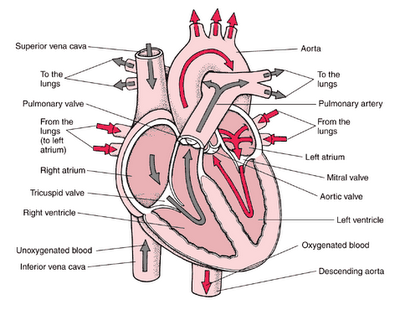
Septum — A separation within the body. It has nothing to do with an old metal tank next to an older house.
Ventricle — One of the two lower chambers within the heart, the Right and Left Ventricle. The LV circulates blood from the lungs to the heart where it picks up oxygen and gets pumped throughout the body. The blood then returns to the RV which circulates blood from the heart to the body again, and returns to the lungs to make a new run. It’s a big figure eight. The two upper chambers are called Atriums. Blood enters the heart through the atriums (like the foyer of a house) and exits through the ventricles.
Ventricular Septal Defect (VSD) — A hole between the two ventricles. In Olivia’s case, the middle wall between the left and right ventricle is almost non-existent; about three-quarters of the middle wall did not form. This makes the blood slosh back and forth between both ventricles and become diluted instead of being pumped throughout the body like normal.
Murmur — When blood sloshes back and forth between both ventricles. This was the first indication that Olivia may have further complications.
Oxygen Saturation — The amount of oxygen within the bloodstream. For Olivia, this number (usually 95–100% in a normal person) has been steadily decreasing each day, and it drops sharply quite often for a few seconds or several minutes.
Desaturation — When the amount of oxygen within the bloodstream makes a sharp drop. Depending on additional signs, this could mean bigger problems.
Pulmonary — Having to do with the lungs and respiratory system.
Hypertension — Pressure. Pulmonary hypertension, then, would be pressure on the lungs or respiratory system.
Cardia — Having to do with the heart system (cardiac, cathartic, etc.).
Catheter — Any tube inserted into the body, but each one has a different purpose: investigation (testing), insertion (putting stuff in) or excavation (getting stuff out).
Cardiac Catheterization — Testing the heart by using a tube designed to gather information: volume of blood the heart pumps, diameter and length of arteries and veins, location of main aortas, location and extent of the VSD, etc. This will probably be accompanied with injecting a dye into the bloodstream so they can map out what it looks like in there.
Apnea — To stop breathing momentarily. Olivia has this as a side effect of one of the medicines she is being given. It’s a bit unsettling when you are holding her.
EKG/ECG — Electrocardiogram: a test that measures the electrical activity of the heartbeat and shows it with real-time pictures. It’s just like a sonogram for seeing a baby in the mother’s womb. Black and white is still classy, right?
Shunt — An artificial artery (made out of Gortex or Dacron usually). Olivia’s shunt will go from the pulmonary artery to the heart so more oxygenated blood gets pumped throughout her body.
Homograft — A donated body part from another human that will be surgically grafted in. For Olivia, she may be given a donated artery in a few years.
Open Heart Surgery — Surgery that consists of stopping the heart, placing the patient on a machine to keep her alive, working on the heart, replacing it in her body, and restarting her heart. It is now a common surgery, but has the risks you’re thinking of. Getting the shunt is not open heart, but the following two surgeries (and maybe more) are.
No comments:
Post a Comment